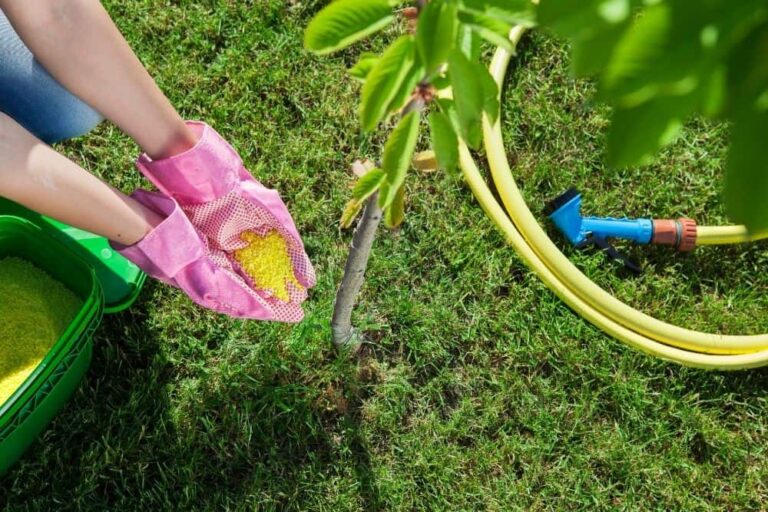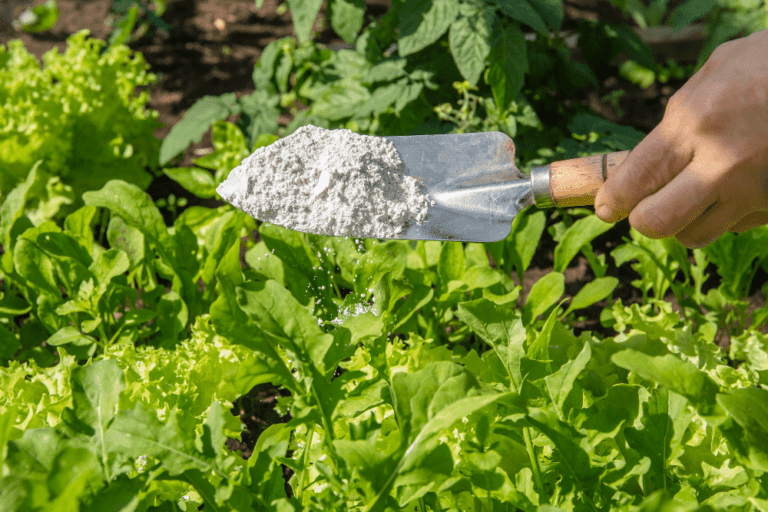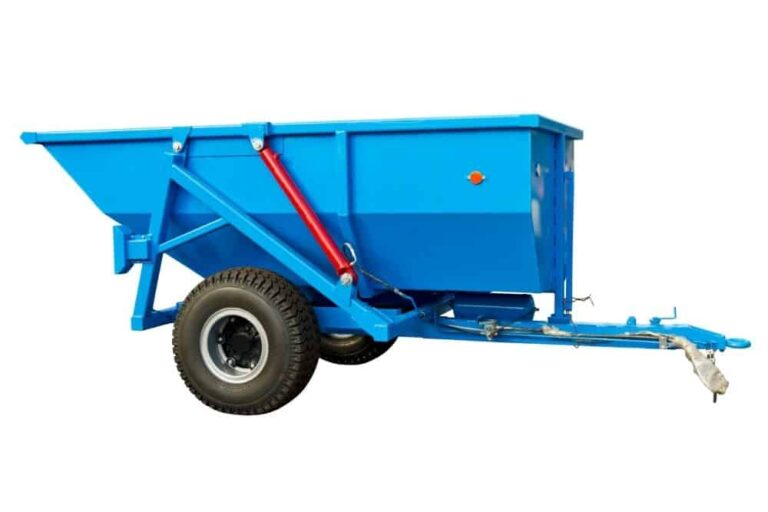How Long Does It Take Grass Seed To Grow From Seed To 2″ Tall
Here’s the thing, the germination of seeds is actually influenced by a whole host of factors.
The germination of seeds is mostly due to the type of grass variant, along with the climate and also the season of the year in which it is planted.
The moisture of the soil also influences the germination of seeds too.
To give an overall estimation of the germination of seeds, we can say that a grass seed will germinate between 5 and 30 days.
However, for your grass seed to grow about 2 inches tall then it will take approximately a month to germinate.
Here, we will go into detail about all of the aspects which have an influence on grass seed germination and growth.
You will also find some interesting tips and hints just to ensure that your lawn has the perfect and also the evenly grown grass.
What Are The Factors That Influence Seed Growth?
As we mentioned earlier, there are a number of factors that have an influence on how grass seeds grow and this is something that we can break down into categories and explore further by doing this.
Let’s Talk Grass Species Or Grass Variant
Here’s the thing, different grass species will actually take different lengths of time to grow fully.
It is important to remember that grass which grows in the colder seasons can actually grow the fastest. In fact, it is between 10 and 18 degrees Celsius where grass will grow the fastest.
For instance, in the warmer climates Bermuda grass will grow the fastest – however Ryegrass germinates the fastest when it is in cooler temperatures.
These seeds will actually take at least 7 to 10 days to germinate.
Both of these types of grass also require the soil to be in different conditions.
For instance, Ryegrass requires for the soil to be damp during the germination period whereas Bermuda grass can be watered once every 3 days. This is true for Bermuda grass even during the hotter seasons.
Additionally, some meadow grass seeds can actually take a couple of weeks to germinate!
When Is The Season Of Planting?
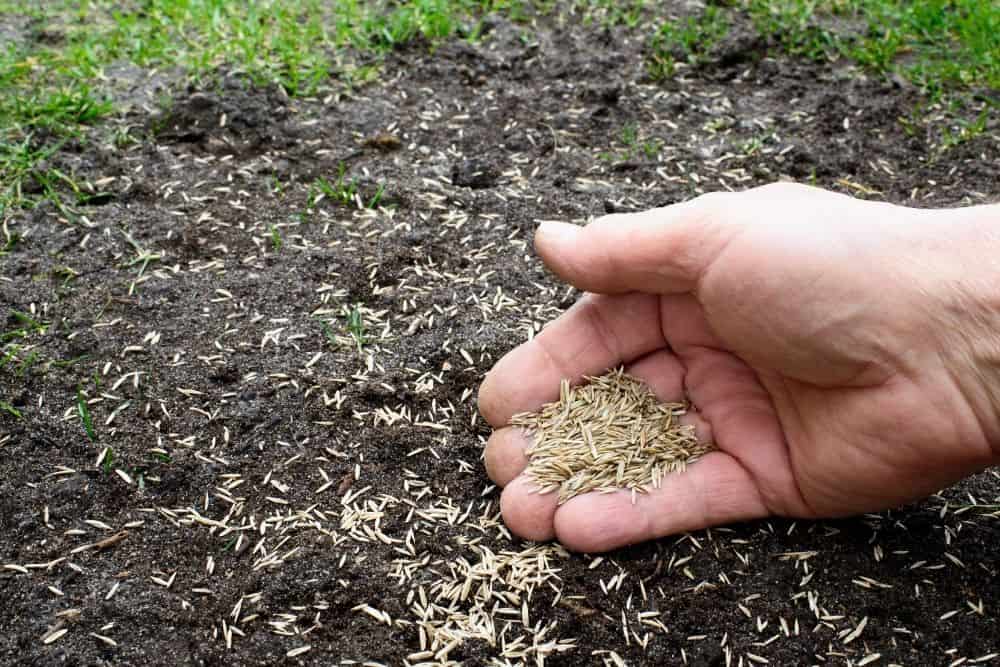
The season of planting is the time of year where the seeds are sown, and this plays a big role in the germination and the growth of the seeds.
In fact, there are 2 types of grasses which are based on the type of season. These are cool-season grasses and warm season grasses.
When it comes to cool-season grasses, these types of seasons will usually be located in the Northwest Pacific, Northeast and Upper Midwest.
They have a pretty active growth period during the times of the early spring along with the early fall.
Cool-season grasses require temperatures that range from 15 right up to 24 degrees Celsius in order to grow and thrive fully.
This kind of grass will turn brown in the summer although in the winter they will be green.
The types of cool-season grasses have varying growing times. For instance, Ryegrass will take anywhere between a week and 10 days, and Tall fescue can take anywhere from 10 days to two weeks.
Then there is the Kentucky Bluegrass which can take anywhere from 2 weeks right up to a month.
When we talk about warm season grasses, it is important to note that these are usually found in the South and in the Southerneastern regions.
Warm season grasses have an active growth period which occurs during the middle of spring or even later spring and this can last right up until the early fall.
Warm-season grasses grow the best in temperatures that range from 27 degrees Celsius right up to 35 degrees Celsius. Warm-season grasses will go dormant in the winter months.
The types of warm-season grasses have varying growing times.
For instance, the Bermuda grass will take anywhere from between a week and 10 days to grow, whereas Buffalo grass can take anywhere from 2 weeks right up to a month to grow.
Then there is Centipede grass which can take anywhere from 2 weeks right up to 21 days to grow.
The Watering Schedule
When it comes to grass watering, you need to make sure that you water your grass in an adequate and optimal way. This is key for any kind of seed, let alone grass seeds, to germinate.
Here’s the thing, if you water the grass too much then you can end up washing away the grass seeds, but underwatering the grass will dry up the soil.
It is important for you to find balance as in both of these cases germination will not take place.
When it comes to knowing how and when to water your grass there are a few things you should bear in mind. You need to create an environment for your grass seeds that is well-watered and therefore moist.
The soil needs to be moist for approximately 6 up to 8 inches deep. This will work to dampen the soil naturally and it will ensure that the soil is absolutely perfect to be able to sow and germinate the seeds.
You must make sure that you water the soil regularly and this will ensure that the soil stays wet. But, as we said before you must ensure that you do not water the soil so that it becomes overly soggy.
You must be sure to monitor the plants along with the amount of sunlight that each area of your lawn receives sufficiently, and this should in turn allow you to water the grass seeds well enough.
Here’s the thing, once the lawn is set you will actually have enough to water approximately an inch each week.
One thing that is especially important to stress is that you should not water the grass seeds during the night time as this can actually keep the soil wet for much longer, and as a result of this you could end up finding fungus in this area.
Watering the lawn area during the mornings will make sure that the water does not evaporate, and this in turn will give the water much more time to percolate.
Why Won’t Your Grass Seeds Germinate?
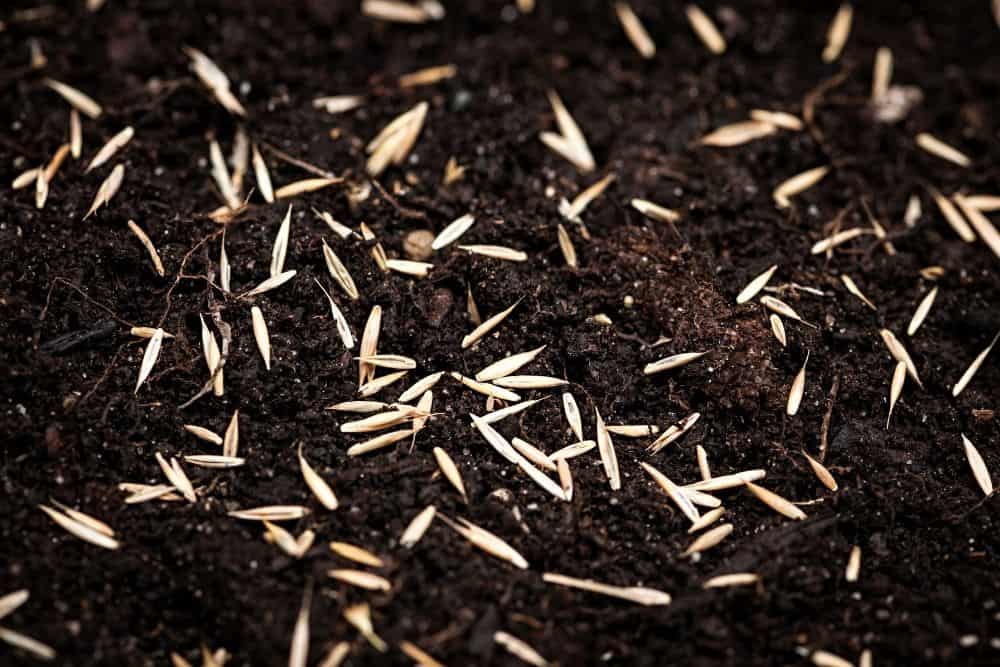
You might find that your seeds might not germinate even if you are following all of the instructions that we stated above.
To make sure that your grass seeds grow to become well-flourished and green then you can also follow these additional steps to ensure that you plant your grass seeds in the correct way.
The Importance Of Soil Testing
One additional step that you can try is soil testing. It is true that testing your soil is very important before you grow any kind of plant, because this will give you an indication of the type of soil that you are dealing with.
From testing the soil, you will be able to gain an understanding of the soil’s nutrient content, the soil’s water retention capacity, along with the pH of the soil – and much more vital information.
This will give you an indication of what type of grass seed you can grow in your soil.
Making Sure That You Prepare Your Soil Properly
So, once you know what soil type you are dealing with you can now move on to soil preparation. In fact, soil prep is something that you can do manually or that you can do with a rototiller.
Soil preparation is something which will help to loosen the soil and this in turn will result in much faster seed germination.
This is the perfect opportunity to add manure to the soil, and when you do this you must select manure that is high in nitrogen content as grass growth would need nitrogen content in much greater quantities.
When it comes to soil prep, you must also remove any unnecessary materials from the soil – this includes debris, giant rocks, pebbles and even wood as all of these materials will greatly hinder grass growth.
You need to ensure that you smoothen and that you level your surface so that your soil has an elegant look about it.
Now, It Is Time To Sow Your Grass Seeds
You might be pleased to know that grass seeds do not actually need you to literally sow seeds. When it comes to grass seeds, you just have to spread the seeds evenly.
A great way to do this would be through using a spreader as this would be a big help to you. Alternatively, this is something that you can also do manually.
What About Topdressing?
This is something that can really help your grass seeds to grow. A great way to really lock in soil moisture would be to put a layer of peat moss down.
This is also a great way to stop the grass seeds from getting wet and from getting washed away. This also protects your grass seeds from being eaten by birds too.
Making Sure That You Keep The Grass Tidy
To have a smooth and to have a levelled lawn you must make sure that you mow the grass when it reaches a height of 3 inches right up to 4 inches.
This will help the maintenance of your lawn, as it will look great and well-maintained.
Can You Plant Grass Seed Over Existing Grass Or New Lawn?
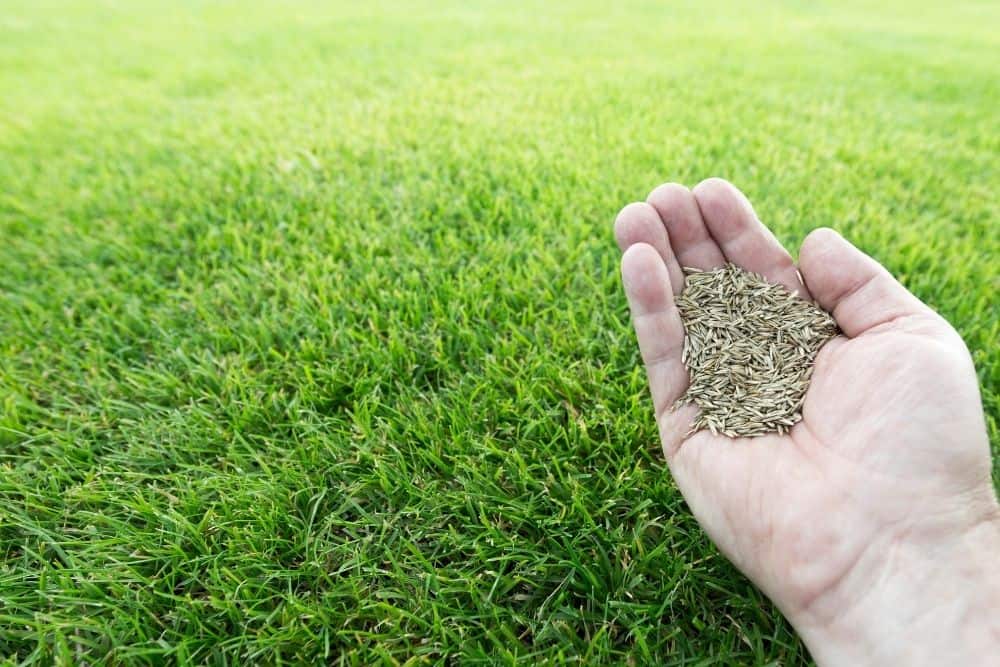
Here’s the thing, when you plant grass seed on an established lawn of some kind then this can actually thicken the grass that is already there.
In fact, it can also help as a preventative kind of method when it comes to warm-season lawn.
What we mean by this is that planting grass seed over existing or new lawn will prevent warm-season lawn from browning when winter comes.
Sowing grass seed is actually a really common element of lawn renovations, this is also referred to as overseeding.
Also, weeds need to be controlled if you are going for this approach and you should also use fertilizer. This will ensure that the condition of the soil should ultimately improve.
To overseed your lawn effectively, you should aim to do this during the early spring or even the early fall – but it is important to note that it is much more preferable for this to be done in the early spring.
The best conditions for grass growth tend to be cool and also rainy weather.
You really need to make sure that you overseed the warm-season lawn with some cool season grass in the fall months – especially if you want a green lawn in the winter.
How can you plant grass seeds on an established lawn? Well, read on to find out…
Make Sure That You Control Those Weeds
We mentioned before that you need to make sure that your weeds are kept in check, because they can end up stealing a lot of benefits that your grass seeds will appreciate.
For instance, weeds can battle it out with seeds for nutrients, light and also water. This is why you need to ensure that you get rid of the weeds before you try to reseed the grass.
Prepare Your Lawn
Now you can move on to making sure that your lawn is totally prepared.
You need to make sure that you aerate, dethatch and also mow your lawn before you even consider beginning the overseed planting process.
We recommend that you mow your grass at the lowest setting just before you plant your grass seed on your established lawn – and after applying any herbicide too.
This will mean that the grass blades will cut only above the soil level.
This is a perfect opportunity for you to check for thatch and also for you to rake up any grass clippings – this layer can be formed by moss, or plant leaves, or even dried lawn clippings.
You can use a rough rake or a dethatcher to resolve this if you have an especially thicker layer of thatch.
It is important to note that half of the thatch should be stripped from the lawn, and then the remainder should be left as a mulch. This means that the soil is ready for the lawn grass to be established.
Don’t forget to get rid of soil plugs and you should break these up with an aerator just to let water and air reach your grass roots.
Sowing The Grass Seeds
Here’s the thing, the rate at which you sow the grass will ultimately depend on the grass variety that you use.
Both warm-season and cool-season grass types are very intrusive, so they can still sprout pretty well in wet weather with effective aftercare.
We recommend that you consider sowing your grass seeds at a much faster rate in hotter climates or in bad weather conditions.
To do this you can use a broadcast, or a drop, or even a handheld spreader just to sow your grass seeds.
You should even consider making two even passes over your lawn, and the way that you do this is by dividing your seed into two piles.
One pile should go up and down and then the other should go side to side. This will ensure that the entire lawn is spread in a uniform manner.
If you are struggling to work with bare patches of grass then we recommend that you try to sow grass seed up to three more times on these patches as this will help to make the grass grow a lot thicker.
To Fertilize Or Not To Fertilize… That Is The Question!
To get the best possible results with your lawn, then your grass seeds will need a lot of fertilizer and a lot of water too. You should apply lawn fertilizer depending on the soil test results that you get.
Also, the suggestions for your region before planting the grass seed will also have an effect on this. You need to ensure that you rake the soil so that you allow the fertilizer to penetrate.
Once you have done this you can then water your lawn until your soil is saturated.
Conclusion
Here we have it, our guide on how different types of grass seeds need different types of treatment to germinate and grow from a small seed right up to 2” tall.
Here we have outlined all of the ways that you can choose your perfect grass type for your lawn, as we have outlined exactly how long each type of grass will need to germinate and grow.
We have also illustrated the different conditions and needs that your grass seeds will need in order to grow effectively.
If this is completely new territory to you, and if you have never done this before, then you should definitely listen to our advice and this should give you a much better idea on how to grow your lawn right from scratch.
Additionally, it is especially important to understand how to go about planting grass seed on an existing lawn.
By doing this, you can really enjoy the greenest grass all year round – or you will be able to give your grass an upgrade to a much thicker turf.
As we said before, when you are planting grass seed on an existing lawn then you need to weed, then fertilize and then understand the kind of soil that you are dealing with.
So, all that is left to do is to just go for it. If you never try you never know, and with our advice you really can’t go far wrong.

